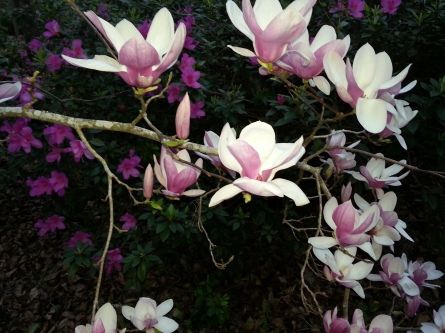(Sprinkled throughout this post is my first attempt at footnotes. Click on the awkwardly placed, light blue numbers [1-6] and you will be whisked to the footnoted material at the bottom of the post. Click on the little ![]() at the end of each footnote to return to where you left off reading.)
at the end of each footnote to return to where you left off reading.)
*****************
I awakened before dawn to 29 degree temperatures and reached the kitchen in time to hear gloom and doom blaring from the radio. It was 4:33 a.m.
“Temperatures will reach 20 degrees just before dawn,” the weatherman predicted emphatically, as if he were never wrong.
I’d heard that it was always darkest before the dawn 1, but my experience has added that it is often coldest before the dawn too. But how could it drop 9 more degrees in the 2 remaining night hours when it had only decreased 12 since my arrival home from work the night before?
My brain considered the weatherman’s forecast unlikely, but my heart chilled as I watched the digital thermometer change from 29.7 to 29.1.
“God, please protect the azaleas,” I breathed.
I can handle the cold — well, at least as cold as it gets in Florida, depending on what activities I am required to complete in the cold — but the flowers can’t. While other folks dress their bushes in sheets and blankets, my azaleas remain unclothed; our bushes are too many and too big to attempt such a lavish wardrobe 2. We trust the oaks and pines and sycamores to cover these native, hearty azalea bushes, but long-lasting temperatures below 32 negate that protection. My car windows remain frost-free and unfazed, but spring, in all its tentative glory, is frozen in place.
And it isn’t pretty.
At first, my azaleas appear like the clocks in Salvador Dali’s “Persistence of Memory,” droopy, uncomfortably stretched, as if they were melting rather than freezing on their branches. If I take off my glasses and gaze at the bushes from a distance, I can pretend these colorful splotches are still flowers in bloom. But as the days pass they change from those beautiful pinks and whites to brown scabs 3, just itching to be picked or pulled from their tenacious perching, unsure if their removal will leave fresh health or a gaping wound.
The bees, once so busy with the multitude of flowers, won’t know what to do with themselves. I hope they won’t find me a happy, second choice.4
The night before the hard freeze, I pulled into my driveway, trying to memorize the vision of azaleas abloom in our front yard, hoping the temps wouldn’t dip low enough to distort that beauty 5. As it happened, as it got “darkest before the dawn,” it also got coldest just before dawn — but it didn’t drop to 20 as forecast. The damage, however, was done; the 29 degree temps were enough to zap the flowers in full bloom.
I wish that I could gloat that the weatherman spewing his gloom and doom was wrong (and he was — just not wrong enough to do the azaleas any good). I’d rather gloat that God had listened to my prayers and saved the flowers. Silly prayer, I know, but it seems that God would care 6. It seems so utterly pointless to cultivate this early spring only to allow a random cold snap to transform beauty into scabs.
As I went outside that evening to shoot some photos of frozen azaleas for this post, I noticed some buds and blossoms that seemed untouched by the freezing temperatures. Though but few remained unscathed, it was oddly comforting.
That evening, when my husband said the blessing over dinner, he added, “And thank you for the time we did have to enjoy the flowers.”
After my dread and breathed prayers and laments and whines, it was that little statement inserted into a prayer that gave me the better perspective: thankfulness.
I’d forgotten that.
- The saying “It’s always darkest before the dawn” is a rough translation of English theologian and historian Thomas Fuller’s 1650 version: “It is always darkest just before the Day dawneth.” His thought — metaphoric rather than scientific — is that we can have hope even in the midst of the worst circumstances, the idea that just as life seems darkest or at its worst, relief is on the horizon. ↩
- Funny, as I was wondering about azalea care, I landed on a few sites that did encourage dressing azaleas — but when the temperatures were to reach 25 degrees. Of course, those sites also suggested limiting watering to help the plants go dormant, which aids in protecting them from winter cold snaps. Unless I could make the trees act as umbrellas when we get our weekly rains, I can’t control how much water these plants get, which is likely why they are susceptible to these cold temperatures hovering just below freezing. ↩
- This is Florida, after all, originally named by discoverer Ponce de Leon, who arrived here during the Easter season and aptly called it Pascua Florida or “Flowery Easter,” loosely translated from the Spanish into “Feast of Flowers.” Lent began Wednesday, so we are officially in the Easter season; if Mr. de Leon had arrived today, our state might well be named Arbustos Costrosas, Spanish for “Scabby Bushes.” I am thankful his landing 500 years ago was welcomed with beautiful flowers. I wish my Easter season were as well. ↩
-
The bees actually were out in full force, despite the condition of the flowers. Bumble bees and honeybees, such as this one, were quite active. Even getting close to shoot a photo, I was safe from the bees. Of course, they still have the flowers as a first choice for a couple of days…
 ↩
↩
- Whatever happened to “global warming” or “climate change”? Every year, our flowers bloom — too often to be threatened by record low temperatures and nipped in the bud. This time, the high two days later is predicted to be in the 80s. I wish the weather could find a happy medium. ↩
- “Consider the lilies, how they grow: they neither toil nor spin, yet I tell you, even Solomon in all his glory was not arrayed like one of these. But if God so clothes the grass, which is alive in the field today, and tomorrow is thrown into the oven, how much more will he clothe you, O you of little faith!” (Luke 12:27-28) ↩









